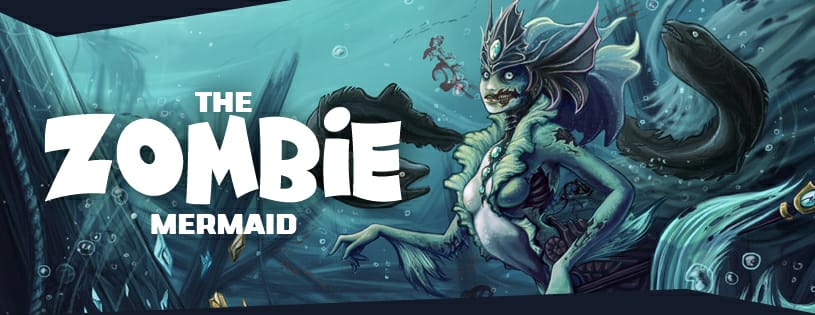Zombie Reconstructions in Contemporary Society: the Zombie Mermaid

At this moment, I am working on a chapter for an edited volume called “Deconstructing the Zombie: Cultural and Ideological Approaches”. It can hardly be a surprise that I am working on the composite character of the Zombie Mermaid. 😉 As I am very keen on your feedback and suggestions (some more case studies, anyone?), I thought it would be nice to share some of my work-in-progress with you.
While browsing social media through the keyword “zombie”, one quickly stumbles upon a whole new subgenre of this fictional undead being: the zombie mermaid. Thousands of users on Tumblr and Instagram use the hashtag #zombiemermaid, mostly to show their costumes, cosplay and makeup art. Once again, the zombie as an archetype has suffered a transformation in order to adapt itself to the different contextual circumstances that have surrounded its figure.
After an exploration of this new composite character and its roots, my chapter will explain how the Zombie Mermaid and its sub-type Zombie Ariel relate to other tropes in the zombie and mermaid genres. For example, just like other zombies, the zombie mermaid is “undead” and many ideas behind the living dead can also be found in stories about mermaids, such as not having a soul. As a very feminine variant of zombie types, this new trend raises questions about female agency and empowerment. Therefore, special focus will be on how (co-)creators reflect upon female agency through their monsters, and what this tells us about the reception of border crossing as a feminist strategy.
Although there is no scholarly discourse about this phenomenon, yet, the depiction of the zombie mermaid seems to fit in the well-researched larger and older traditions of horror mermaids. The differences between those two categories will be explored by looking at examples of these historical horror mermaids in Japanese folklore (for example the Ningyo), Greek mythology (like the Sirens) and the constructed “hybrids” of mummified fish and ape parts (such as the Fiji Mermaid). More recent examples can be found in the 1988 movie ‘Mermaid in a Manhole’ (which is strongly rooted in Japanese folklore about ningyo and other horror mermaids), in the 2001 television film ‘She Creature’, in the 2003 American exploitation horror film ‘House of 1000 Corpses’ and in the 2004 Japanese action comedy film ‘Oh! My Zombie Mermaid’.
Even though these horror mermaids may have served as inspiration for the zombie mermaid cosplay, to find ‘real’ zombie mermaids, double hybrid creatures that have characteristics of mermaids and zombies, it seems that we have to return to the Internet, the ‘wonderfully sprawling repository of arcane fictions and crypto-everything’ as Sheila Hallerton describes it. ‘Its fragmentary and often inter-generative texts thrive and gain momentum with the slightest (and often most erroneous) of pretexts, generating threads of online mythology that variously intersect with older folkloric and mythological stories or else develop independently.’ (Hallerton 2016)
In my view, online fanart can be regarded to as a modern form of the creation of myths and legends. Not only are we together around the campfire to tell the latest adventures of our heroes, but we also find each other on the Internet. As Jenkins (2004/2003) proposes: “fans reject the idea of a definitive version produced, authorized, and regulated by some media conglomerate. Instead, fans envision a world where all of us can participate in the creation and circulation of central cultural myths” (289).
Online, the ‘genuine’ Zombie Mermaids can not only be found in cosplay, but also in fanfiction, such as Michelle McCrary’s ‘The True Story of the Little Mermaid’ (2011), in which even Andersen’s mermaid eventually becomes a zombie mermaid. Such a ‘repossession of the text by fans […] creates a new avenue for expanded audience autonomy vis-à-vis media texts'(Sullivan 2012 : 203). My research thus shows how fanart can be a valuable contribution in terms of autonomy. It should be taken seriously as a contemporary form of resistance against undesired representations.
Leave a Reply